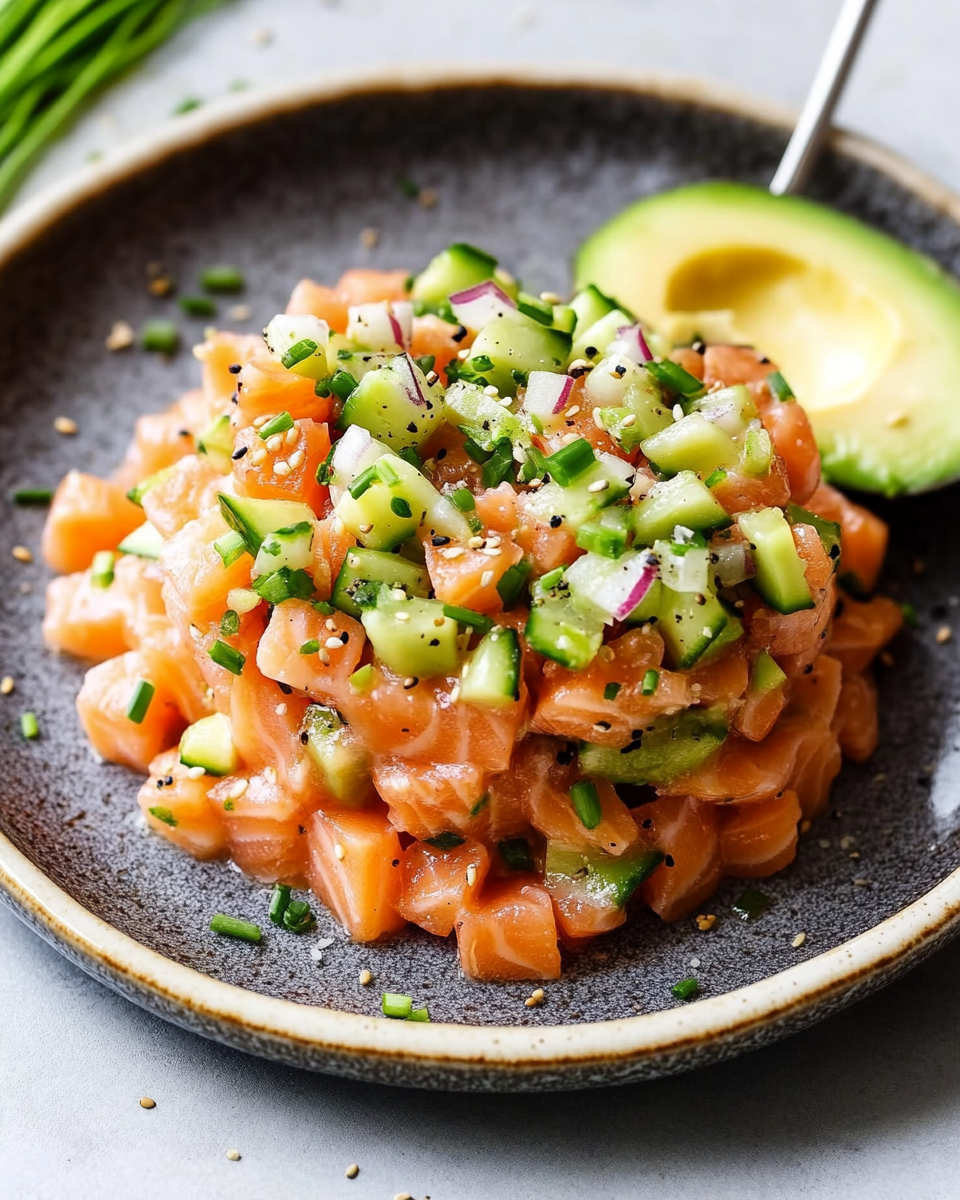This elegant Salmon Tartare is everything a refined appetizer should be light, fresh, and bursting with flavor. The hand-diced salmon blends beautifully with creamy avocado and crisp cucumber, while a delicate soy-sesame dressing adds a rich umami finish. It’s a no-cook dish that looks like it came straight from a fine dining restaurant. Perfect for dinner parties, romantic evenings, or impressing at your next gathering, this tartare is as quick to prepare as it is visually stunning. Garnish with microgreens and serve with crisp toasts or wontons for a bite that’s sophisticated yet effortless. It’s a modern classic for the health-conscious gourmet.
Full Recipe:
Ingredients:
-
8 oz sushi-grade salmon, finely diced
-
1 ripe avocado, finely diced
-
1 small cucumber, peeled and finely diced
-
1 tablespoon shallot, finely minced
-
1 tablespoon fresh chives, chopped
-
1 teaspoon sesame seeds
-
1 teaspoon soy sauce
-
1 teaspoon sesame oil
-
1 teaspoon freshly squeezed lemon juice
-
1/2 teaspoon Dijon mustard
-
Flaky sea salt and freshly cracked black pepper, to taste
-
Microgreens or radish sprouts, for garnish
-
Toasted baguette slices or wonton crisps, for serving
Directions:
-
In a mixing bowl, combine diced salmon, avocado, cucumber, shallot, and chives.
-
In a small bowl, whisk together sesame seeds, soy sauce, sesame oil, lemon juice, and Dijon mustard until emulsified.
-
Pour the dressing over the salmon mixture and gently toss to combine. Taste and season with flaky sea salt and black pepper.
-
Chill in the refrigerator for 10–15 minutes to let flavors meld.
-
Serve in a ring mold for presentation or spoon gently into a shallow bowl. Garnish with microgreens or sprouts.
-
Pair with toasted baguette slices or wonton crisps for a perfect bite.
Prep Time: 15 minutes | Cooking Time: 0 minutes | Total Time: 15 minutes
Kcal: 260 kcal | Servings: 2 servings
A Refined Dish with Global Roots
Salmon tartare is a dish that embodies both simplicity and sophistication. Though often associated with fine dining and haute cuisine, its roots trace back to the traditional preparation of raw meats and seafood in various global cuisines. Much like beef tartare, its namesake, salmon tartare is made with finely diced raw salmon and dressed with flavorful seasonings that enhance the freshness and texture of the fish. But unlike heavier raw preparations, salmon tartare is often more delicate, clean, and elegant on the palate.
The modern twist on this classic includes fresh elements such as creamy avocado and crisp cucumber. These ingredients not only complement the richness of salmon but also add a vibrant texture contrast that elevates the dish into a refreshing starter or light meal. Combined with a tangy soy-sesame dressing and garnished with microgreens or sprouts, this salmon tartare is as visually striking as it is delicious.
Whether served in upscale restaurants, trendy seafood bars, or home kitchens of culinary enthusiasts, salmon tartare has become a universal favorite and for good reason.
Why Choose Raw?
The idea of eating raw fish may be intimidating to some, but with the rise in popularity of sushi, poke bowls, and sashimi, many have developed a newfound appreciation for the clean, buttery flavor and soft texture of uncooked seafood. High-quality, sushi-grade salmon is not only safe to consume raw when handled properly, but also incredibly nutrient-dense.
Raw salmon retains more of its natural omega-3 fatty acids, which are known for supporting heart and brain health. Cooking can degrade some of these beneficial fats, so raw preparations like tartare offer a wholesome and delicious way to enjoy the full nutritional benefits of the fish. The addition of avocado further enhances the health profile of the dish with its heart-healthy monounsaturated fats, while cucumber provides hydration and crunch with minimal calories.
A Balance of Flavor and Texture
What makes this particular salmon tartare special is the harmony between bold and subtle elements. Each ingredient plays a critical role:
-
The salmon delivers rich, umami flavor with a tender, almost melt-in-your-mouth texture.
-
Avocado brings creaminess and a mellow, buttery taste that softens the boldness of the fish.
-
Cucumber contributes a crisp bite that refreshes the palate.
-
The dressing, typically made with soy sauce, sesame oil, lemon juice, and a touch of mustard, ties everything together with savory, tangy, and slightly nutty notes.
The interplay between these components results in a dish that feels indulgent without being heavy. It’s light enough to serve as an appetizer, yet satisfying enough to stand on its own for a warm-weather lunch or brunch entrée.
Presentation Matters
One of the hallmarks of salmon tartare is its elegant presentation. Often molded into a circular form using a ring mold, the layered combination of salmon, avocado, and cucumber looks like edible art. For those hosting a dinner party or special occasion, this makes it a fantastic starter to impress guests.
Beyond the shape, garnishing plays a role in elevating the visual appeal. Microgreens, edible flowers, sesame seeds, or a fine drizzle of additional dressing can turn a simple plate into something that would look right at home in a Michelin-starred restaurant. And let’s not forget the importance of serving accompaniments whether it’s delicate toasted baguette slices, crispy wonton chips, or even cucumber rounds, these vehicles add both style and crunch to each bite.
Variations to Explore
This salmon tartare recipe is versatile and open to interpretation. Here are several ways to customize it based on preference or dietary needs:
1. Spicy Kick
Add a small amount of Sriracha, wasabi, or finely chopped chili pepper to the dressing for a spicy version. You can also fold in a bit of grated ginger for warmth.
2. Citrus Twist
Swap lemon juice for yuzu or lime juice to give the tartare a zesty, tropical flavor. A small amount of orange zest can also add brightness.
3. Herb Infusion
Fresh herbs like dill, cilantro, or Thai basil can bring another layer of complexity. They can be mixed in or used as garnish.
4. Asian Fusion
Incorporate elements such as ponzu sauce, pickled ginger, or nori flakes for an Asian-style twist. Some versions even include a hint of miso paste in the dressing.
5. Vegetarian Alternative
For those who don’t eat seafood, you can create a mock tartare using finely diced beets or watermelon, avocado, and cucumber, dressed in the same way.
Pairing Suggestions
When it comes to serving this elegant tartare, consider these pairings for a complete experience:
-
Beverages: A crisp white wine like Sauvignon Blanc or a dry rosé complements the flavors beautifully. For a non-alcoholic option, cucumber-infused sparkling water or cold green tea works wonderfully.
-
Sides: Serve with a light salad, chilled edamame, or a refreshing gazpacho as a starter course.
-
Bread and Chips: Crostini, rice crackers, or seaweed crisps offer the ideal crunch to contrast the softness of the tartare.
Safety First: Handling Raw Fish
It is essential to use sushi-grade salmon from a trusted source to ensure safety when preparing this dish. Sushi-grade means the fish has been frozen at a temperature that kills parasites, making it safe for raw consumption. Always keep the salmon refrigerated until ready to use, and consume the tartare within a few hours of preparation.
If you’re unsure about sourcing raw fish, some specialty seafood counters or Japanese markets label items specifically for raw use. When in doubt, ask your fishmonger for guidance.
Great for Entertaining or Meal Prep
Salmon tartare is ideal for entertaining guests. It’s quick to prepare and doesn’t require any cooking, which frees up time for the host to focus on other aspects of the meal. It’s also scalable, meaning you can easily double or triple the recipe to serve a crowd.
Interestingly, it also works well as part of a meal prep routine for clean, high-protein lunches. Simply prep the ingredients (keeping the avocado separate until ready to serve) and assemble just before eating to maintain freshness.
A Versatile Year-Round Favorite
Although especially popular during the warmer months, salmon tartare isn’t restricted to summer fare. Its rich yet light character makes it appealing year-round. You can incorporate seasonal variations adding mango in summer, pomegranate seeds in fall, or even topping with a soft quail egg for a winter version that feels more indulgent.
Conclusion:
Salmon Tartare with Avocado and Cucumber is more than just a trendy appetizer it’s a timeless dish that combines the freshness of raw seafood with flavorful seasonings and creative flair. Whether you’re a home cook looking to impress guests, a health-conscious eater seeking a clean and protein-rich meal, or someone who simply loves exploring raw preparations, this recipe checks every box.
Not only does it deliver on taste and texture, but it also showcases how a few high-quality ingredients can come together in a dish that feels luxurious yet accessible. With endless ways to customize, minimal preparation time, and impressive visual appeal, this salmon tartare deserves a permanent spot in your culinary repertoire.






